St
Lawrence's Hospital
Coulsdon Road, Caterham, Surrey CR3 5YA
Medical
dates:
Medical
character:
Mental handicap
Among its other duties in 1867, the newly formed Metropolitan Asylums Board (MAB) was charged with providing healthcare for 'insane paupers' living in workhouses but unlikely to be harmful or dangerous. (Violent patients were sent to the county lunatic asylums.)
MAB planned two asylums, one to serve patients from north London and one for those from south London. Both were to be built to the same design by John Giles (the architect of the Langham Hotel in central London), allowing for differences in local topography. Each was intended to accommodate 1560 patients in six 3-storey blocks for 860 females and five blocks for 700 males.For the south London asylum a 154-acre site on the high plateau of the Surrey Downs, northwest of Caterham, was purchased at a cost of £5,756. The foundation stone was laid in April 1868 by Dr William Brewer, Chairman of MAB. A single-track railway line was laid from Caterham Junction by the contractors to enable materials to be brought to the site.
The Metropolitan District Asylum for Chronic Imbeciles opened on 9th October 1870, one week after the official opening of its twin Asylum at Leavesden (the first 12 patients had been admitted a week earlier, although the Asylum was far from complete and had no proper water supply). A special train had been provided on the single-track line to convey visitors to the opening ceremony.
The opening of both Asylums reduced the number of insane patients in London workhouses by one-third.
As at Leavesden, the six female ward blocks were on the west side of the central administration building; five of these blocks were general and each had accommodation for 160 patients. The wards were 107 feet long and 37 feet wide, each with accommodation for more than 50 beds. The southerly block was an infirmary with 60 beds. On the east side, three ward blocks for male patients had 160 beds, while the fourth was shorter and contained only 110 beds, but could be extended later to provide the additional 50 beds. Epileptic patients were housed in the second block on each side. The southerly block was again an infirmary, giving the male side a complement of 650 beds. A detached infirmary for infectious diseases patients was built at the north of the site.
The central administration block contained the offices and Board Room at its southern part. The centre was occupied by the general stores, with small store rooms leading off. To the north were the kitchen, scullery, larder, dairy and meat store. The laundry was at the northern end of the block, with the bath-houses at the very end. Each bath-house - one for males and one for females - contained 12 baths, dressing rooms and WCs. Various workshops were on either side of the central block. The new buildings had cost about £85,000.
In November 1870 admission of patients had to be stopped because of a shortage of water. A well had been begun, but no water had been struck in the original shaft, and none was found until a long gallery was dug. Water gushed so rapidly that the workmen had to flee, abandoning their work tools. Once filled, it could never be pumped dry, and eventually the local water works and neighbouring Brigade of Guards Depot were also supplied by it. Water pumps were working by March 1871, although there were still problems with the kitchen and laundry equipment.
By May 1871 - eight months after it had opened - the Asylum had 1444 patients. In 1872 it had 1672 patients.
In 1873 an additional block for 160 female patients was built, as well as a recreation hall with a stage, at a cost of £12,493. A dormitory over the hall housed another 50 patients. Children had initially been admitted to the Asylum but, in 1873, MAB was persuaded that they should have their own institution. While this was being built at Darenth, the children were removed and sent to the vacant Hampstead Smallpox Hospital.
In 1875 a new male block was built, as well as a swimming pool (this survived until 1975 when it began to leak and was closed). In 1876 a similar block was built for female patients. By 1877 there were 2000 patients.
By 1881 the Asylum was also known as the Caterham Lunatic Asylum for Safe Lunatics and Imbeciles. In 1885 iron fire escapes were added to the buildings. In 1889 a Nurses' Home was built.
By the end of the 19th century both it and the Leavesden Asylum were severely overcrowded and, in 1903, MAB built a new asylum at Tooting Bec to relieve the pressure on both Asylums.
In 1913, under the Mental Deficiency Act of that year, MAB became responsible for mentally defective pauper children. When 'untrainable' boys at Fountain Hospital reached the age of 8 years, they were transferred to the Caterham Asylum. Similarly, semi-educable children not up to the standard of the Darenth Training Colony were sent to Caterham. The Asylum also had a large proportion of older patients, many of whom had no chance of improvement. At this time 23.6% of its patients were epileptic.
During WW1 the Asylum suffered from a shortage of staff, who had enlisted for service (18 members of staff were killed in action).
In 1920 the Asylum was renamed the Caterham Mental Hospital. It had 2109 beds. In 1928 gas lighting was replaced by electricity.
In 1930 the LCC took over administrative control. One of the last acts of MAB had been to purchase a large house - Chaldon Mead - a mile away from the Hospital, as a hostel for high-grade male patients (the LCC opened it in 1931 as the first as its kind). The Hospital at this time had 2068 beds, as well as a nursery unit. In 1935 a pathology laboratory and an X-ray Department were added. The Nurses' Home was enlarged.
During WW2 it became part of the Emergency Medical Service (EMS), as the Caterham Emergency Hospital, making 448 beds available for civilian air-raid casualties, medical and surgical military patients from the local barracks and patients evacuated from general hospitals in London. An annexe was built to treat civilian patients suffering from venereal disease (this was later adapted into lecture rooms and staff accommodation as there was no longer a demand for the service). The Hospital suffered some bomb damage, the worst incident being in November 1940, when a stick of bombs fell across the buildings. A nurse was fatally injured and much damage was caused. In another incident a bomb fractured the main sewer. Seven members of staff were killed in action during the war.
In 1941, when it had 2159 beds, it was renamed St Lawrence's Hospital, after the parish in which it stood. Use of the EMS beds returned to the Hospital in 1944. The Hospital estate was in poor shape due to war damage, lack of renovation, repair and redecoration over the war years, and its furnishings and equipment antiquated and of obsolete design.
In 1948 the Hospital joined the NHS under the auspices of the South West Metropolitan Regional Board. One male ward and two female wards were closed due to lack of staff or need of repair, so 170 of its 2256 beds were unavailable.
In the 1950s the Coronation Pavilion was built as an entertainment facility and function room for patients, staff and visitors. An Occupation Centre was also added to provide workshops in metalworking and printing. In 1955 Whyteleafe House opened as a hostel for high-grade female patients.
By 1971 it had 1902 beds. Woodhurst at Pease Pottage, near Crawley, once an annexe of the South London Hospital for Women, was transferred to the control of the St Lawrence's Hospital Management Committee. Following a reorganisation of the NHS in 1974, the Hospital was transferred to the control of the Croydon Area Health Authority, part of the South West Thames Regional Health Authority.
In 1981, when the Hospital had 1320 patients, 'Silent Minority', a TV documentary about conditions in two mental hospitals (St Lawrence's and the Borocourt Hospital near Reading) drew attention to the poor conditions in such places, exacerbated by staff storages. The media began to take an interest in patient care in hospitals for the mentally handicapped and several were investigated by government inquiries (A report on South Ockendon Hospital was published in 1984).
In 1982 St Lawrence's Hospital became part of the Croydon District Health Authority. By this time patients were gradually being taught how to cope with life outside an institution, enabling them to move to homes and hostels in the community and to enjoy a degree of independence. Between 1985 and 1990 the number of patients at the Hospital had been reduced from 1193 to less than 400.
The Hospital became part of the Lifecare NHS Trust in 1991, when it had 992 beds (including those at its smaller homes - Chaldon Mead, Whyteleafe House, Woodhurst, and Canterbury House in Upper Norwood). Bourne Lea, a separate property in the grounds of the Hospital was refurbished for use as a home for people with severe challenging behaviour (the former residents who had sensory defects were transferred to The Oaks in Kenley).
Parts of the Hospital were boarded up in 1992 and, by May 1993, there were only 170 patients left. The Hospital finally closed in 1994.
Present status (July 2008)
All the Hospital buildings, with the exception of one ward block at the southeast corner of the site, have been demolished. Most of the site has been redeveloped as a mix of small and large houses. At the south is the Oaklands House complex, a scheme of small houses of 10 to 8 rooms for people with learning difficulties, which belongs to the Surrey and Borders Partnership NHS Foundation Trust. The complex includes Bourne Lea.
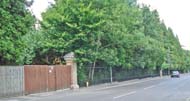
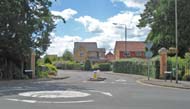
Perhaps the original fence and pillars
of the Hospital on Coulsdon Road (left) and the
original gateposts leading to Hambledon Road (right).

The former Nurses' Home has been converted into housing.
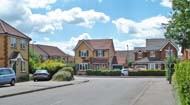
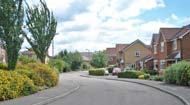
Housing along St Lawrence Way at the north of the site.
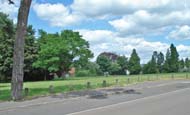
An open space in the centre of the site.
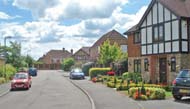
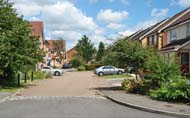
Marcuse Road is at the centre of the site.
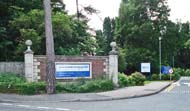
The entrance to the Oaklands House complex is off Coulsdon Road to the south.
Deacon JJ 1974 Tongue Tied: Fifty Years of Friendship in a Subnormality Hospital. London, National Society for Mentally Handicapped Children.
Gibson J 1957 St Lawrence's Hospital, Caterham, Surrey. 1870-1956. Caterham, St Lawrence's Hospital.
Gilbert W 1872 The Idiot Colony at Caterham. Good Words 13, 271-177.
Malster R 1995 St Lawrence's: the Story of a Hospital 1870-1994. Caterham, Lifecare NHS Trust.
http://hansard.millbanksystems.com
http://meanwoodparkhospital.fotopic.net
http://studymore.org.uk
www.aim25.ac.uk
www.communitycare.co.uk
www.elfrida.com
www.frithphotos.com
www.tanbridge.gov.uk
www.workhouses.org.uk
Return to home page